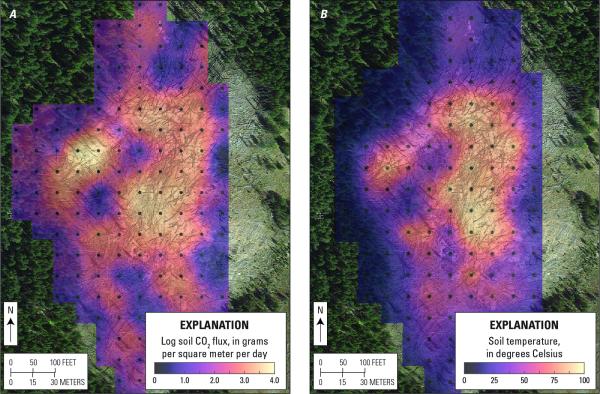
Aerial view of the new thermal area, in the center left. The existing Tern Lake thermal area is the bright white patch of ground in the upper middle part of the image. The west part of Tern Lake is in the lower right. USGS photo by Mike Poland on August 19, 2019.
Editor's note: Yellowstone Caldera Chronicles is a weekly column written by scientists and collaborators of the Yellowstone Volcano Observatory. This week's contribution is from Sara Peek, geochemist with the U.S. Geological Survey.
Thermal areas, where heat from Yellowstone National Park’s magmatic system meets the earth’s surface, are part of Yellowstone’s dynamic landscape. Some of these thermal areas are old and cooling off, like Brimstone Basin on the southeast edge of Yellowstone Lake, but others are quite young and vigorous, like the new thermal area near Tern Lake. This thermal area was first identified using satellite thermal data, and its evolution can be seen in aerial photos and satellite images. (Check it out yourself by choosing “View” -> “Historical Imagery” on Google Earth: 44.6635° N latitude, 110.279° W longitude.)
YVO scientists made an initial visit to the newly discovered thermal area in 2019, identifying a zone of dead trees and hot ground, but also noting regrowth of vegetation in some areas.
The team also noted steam escaping from the ground throughout the thermal area and areas of sulfur precipitation at the surface, so a follow-up expedition was planned to characterize gas emissions. There were two goals for this visit: to measure the total amount of volcanic gas being released from the thermal area, and to determine the composition of the gas.
To measure the amount of gas, a backpack-sized instrument known as a carbon dioxide (CO2) flux meter was carried to the field area. A small open-bottomed chamber with a mixing fan, connected to the flux meter, is placed on the ground. The flux meter measures the accumulation of CO2 in the chamber. This tells us the CO2 emissions of that “chamber footprint,” which is a little less than 0.1 square meter (about one square foot). This is extended over the entire thermal area by making measurements at a pre-determined grid of GPS points covering the area. To achieve a 15 meter (49 foot) spacing, that’s about 200 total measurements. Then, total emissions are estimated by interpolating between the measured points.
The total CO2 emission rate of this new thermal area is about 12.4 metric tons of CO2 per day. This is about half as much, by area, as the nearby and chemically similar Mud Volcano thermal area, and only a small fraction of the total emissions of Yellowstone acid-sulfate thermal areas, which is about 24,000 metric tons of CO2 per day!
Soil temperature measurements at each point confirmed that many of the sites in the core of the thermal area are at boiling temperatures—about 92 °C (198 °F) at that elevation. These high temperatures are found just below the ground at a depth of 20 cm (8 in) and correspond to the sites with the highest CO2 emissions. This makes sense—the gas (especially steam) carries heat from the subsurface, heating the ground as it travels. The gas lurks just below the surface. Sometimes, when the ground was punctured with a thermocouple to measure temperature, gas emissions increased significantly! In more mature thermal areas like Mud Volcano, on the other hand, gas emissions tend to follow established channels, resulting in fumaroles and other degassing features.
To understand the composition of the gas, samples were collected in glass bottles for analysis back in the lab. The largest component of gas emissions at Yellowstone is steam (water), and the remaining gas is primarily CO2, with minor additions of other gases, including hydrogen sulfide (H2S), methane (CH4), nitrogen, oxygen, and other trace gases.

Maps of soil CO2 concentration and temperature measured at a new thermal area near Tern Lake in Yellowstone National Park. A, Map of log soil CO2 flux simulated based on measurements made at the black dots in September 2022. B, Map of soil temperature at a depth of 20 centimeters (8 inches). Note that the area on the right-hand side of each map has bare of forest due to recent tree-kill, but with minimal gas emissions, low temperatures, and small trees re-growing. This is a sign of initially diffuse gas and thermal emissions beginning to concentrate in the core of the thermal area.
Compared to the nearby established Fern Lake thermal area, gas samples from the new thermal area contain more nitrogen and less H2S. The broad distribution of degassing in the new thermal area probably allows the incorporation of more air than in the Fern Lake thermal area. Notably, while the samples contain some oxygen, oxygen levels are considerably lower than in an equivalent amount of air. This is probably because the oxygen has reacted with both H2S in the gas, and hot rock in the subsurface. The incorporation of air explains the higher nitrogen levels and contributes to lower H2S levels due to the reaction with oxygen.
There are also differences in methane concentration between the old and new thermal areas that are not easy to explain through chemical reactions. These variations may suggest that the compositions of the deep gases feeding the two areas are different.
We are watching a new thermal area being born – initially there were no established pathways for gas, resulting in a large area of tree kill. Gradually, gas emissions have concentrated in the core of the thermal area, allowing the regrowth of vegetation in some areas. As the new Tern Lake thermal area continues to evolve, gas emissions and hot temperatures will continue to consolidate, forming fumaroles and possibly reducing the diffuse degassing of the ground. The continued reaction of hot, corrosive gases with the soil and rock will gradually result in more unstable ground. This will eventually change the landscape through the formation of collapse features, as we see in other nearby acid-sulfate thermal areas. Following the evolution of the new thermal area and comparing it to existing, mature features has been, and will continue to be, a very interesting and educational exercise!




 Support Essential Coverage of Essential Places
Support Essential Coverage of Essential Places






